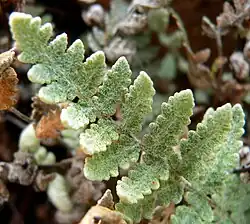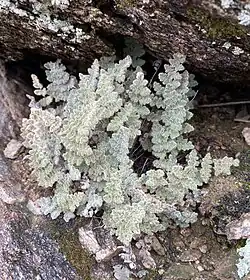Myriopteris parryi
| Myriopteris parryi | |
|---|---|

| |
| Scientific classification | |
| Kingdom: | Plantae |
| Clade: | Tracheophytes |
| Division: | Polypodiophyta |
| Class: | Polypodiopsida |
| Order: | Polypodiales |
| Family: | Pteridaceae |
| Genus: | Myriopteris |
| Species: | M. parryi
|
| Binomial name | |
| Myriopteris parryi (D.C.Eaton) Grusz & Windham
| |
| Synonyms | |
| |
Myriopteris parryi, formerly known as Cheilanthes parryi,[2] is a species of lip fern known by the common name Parry's lip fern.
Description

Myriopteris parryi is a small tufted fern growing from a short creeping rhizome with medium brown scales, most with a darker thread-like mid-stripe. The leaf is usually 6-15 cm long (rarely up to 25 cm) and 1-3 cm wide. The leaf blades are oblong-lanceolate, twice pinnate, and densely wooly. The stipe (leaf stalk) is no more than 1 mm wide and has hairs that range in length, are bent, and are variably appressed to the stipe. Leaf segments are small, nearly round, and flat, with tangled hairs about 4 mm long densely on both surfaces. The adaxial (upper) leaf hairs are silver to white and the abaxial (lower) leaf hairs are tan to brown or golden. The pale hairs on top of the leaflets are often thick enough to make the plant look quite woolly from above. On the underside of the leaf the dark colored sporangia may be buried beneath the coating of hairs.[3] Like many Myriopteris ferns, when conditions are dry the fronds may curl up with their abaxial surface exposed.[4][5]
Range and Habitat
This fern is native to the Southwestern United States, California, and Baja California, where it grows in rocky crevices in the mountains and deserts.[3]
Taxonomy
The species was first described as Notholaena parryi by D. C. Eaton in 1875, from material collected near St. George, Utah. The epithet presumable honors Charles Christopher Parry, who collected it.[6] Karel Domin, who treated Notholaena as a subgenus of Cheilanthes, transferred the species to Cheilanthes as C. parryi in 1915.[7]
The development of molecular phylogenetic methods showed that the traditional circumscription of Cheilanthes is polyphyletic. Convergent evolution in arid environments is thought to be responsible for widespread homoplasy in the morphological characters traditionally used to classify it and the segregate genera that have sometimes been recognized. On the basis of molecular evidence, Amanda Grusz and Michael D. Windham revived the genus Myriopteris in 2013 for a group of species formerly placed in Cheilanthes. One of these was C. parryi, which thus became Myriopteris parryi.[2]
In 2018, Maarten J. M. Christenhusz transferred the species to Hemionitis as H. parryi, as part of a program to consolidate the cheilanthoid ferns into that genus.[8]
Members of the genus Cheilanthes as historically defined (which includes Myriopteris) are commonly known as "lip ferns" due to the lip-like (false) indusium formed by the leaf margins curling over the sori.[9] The common name Parry's lip fern[10] refers to the collector honored by the epithet. Lellinger, who referred to the species as N. parryi, called it Parry's cloak fern.[11]
Based on plastid DNA sequence analysis, Myriopteris parryi is part of the lanosa clade in the Myriopteris genus, with Myriopteris rawsonii its closest analyzed relative.[12]
References
- ^ NatureServe 2024.
- ^ a b Grusz & Windham 2013.
- ^ a b "The Jepson Herbarium".
- ^ "Myriopteris parryi (Parrys's Lipfern)". iNaturalist. Retrieved 2022-10-25.
- ^ Felger, R.S., S. Rutman, J. Malusa, and T.R. Van Devender. 2013. Ajo Peak to Tinajas Altas: A flora of southwestern Arizona: Part 3: Ferns, lycopods, and gymnosperms. Phytoneuron 2013-37: 1–46.| url=https://cals.arizona.edu/herbarium/sites/cals.arizona.edu.herbarium/files/pdf/03PhytoN.pdf
- ^ Parry 1875, p. 351.
- ^ Domin 1915, p. 133.
- ^ Christenhusz, Fay & Byng 2018, p. 19.
- ^ Clute 1901, pp. 237, 242.
- ^ Windham & Rabe 1993.
- ^ Lellinger 1985, p. 154.
- ^ Grusz et al. 2014.
Works cited
- Christenhusz, Maarten J. M.; Fay, Michael F.; Byng, James W. (2018). Plant Gateway's the Global Flora: A practical flora to vascular plant species of the world. Vol. 4. ISBN 978-0-9929993-9-1.
- Clute, Willard N. (1901). Our Ferns in Their Haunts. New York: Frederick A. Stokes Co.
- Domin, K. (1915). "Beiträge zur Flora und Pflanzengeographie Australiens". Bibliotheca Botanica (in German). 20 (85-I).
- Parry, C. C. (1875). "Botanical observations in southern Utah". The American Naturalist. 9: 346–351.
- Grusz, Amanda L.; Windham, Michael D.; Yatskievych, George; Huiet, Lane; Gastony, Gerald J.; Pryer, Kathleen M. (2014). "Patterns of Diversification in the Xeric-adapted Fern Genus Myriopteris (Pteridaceae)" (PDF). Systematic Botany. 39 (3): 698–714. doi:10.1600/036364414X681518. JSTOR 24546228. S2CID 16969741.
- Grusz, Amanda L.; Windham, Michael D. (2013). "Toward a monophyletic Cheilanthes: The resurrection and recircumscription of Myriopteris (Pteridaceae)". PhytoKeys (32): 49–64. doi:10.3897/phytokeys.32.6733. PMC 3881352. PMID 24399906.
- Kirkpatrick, Ruth E.B.; Smith, Alan R.; Lemieux, Thomas; Alverson, Edward, eds. (2014). "Myriopteris parryi". Jepson eFlora, Revision 2. Jepson Flora Project. Retrieved November 12, 2022.
- Lellinger, David B. (1985). A Field Manual of the Ferns & Fern-Allies of the United States & Canada. Washington, DC: Smithsonian Institution Press. ISBN 0-87474-603-5.
- NatureServe (November 1, 2024). "Cheilanthes parryi". NatureServe Explorer. Arlington, Virginia. Retrieved November 17, 2024.
- Windham, Michael D.; Rabe, Eric W. (1993). "Cheilanthes parryi". In Flora of North America Editorial Committee (ed.). Flora of North America North of Mexico. Vol. 2: Pteridophytes and Gymnosperms. New York and Oxford: Oxford University Press.
External links
- Jepson Manual eFlora (TJM2) treatment of Myriopteris parryi
- Myriopteris parryi in the CalPhotos photo database, University of California, Berkeley
